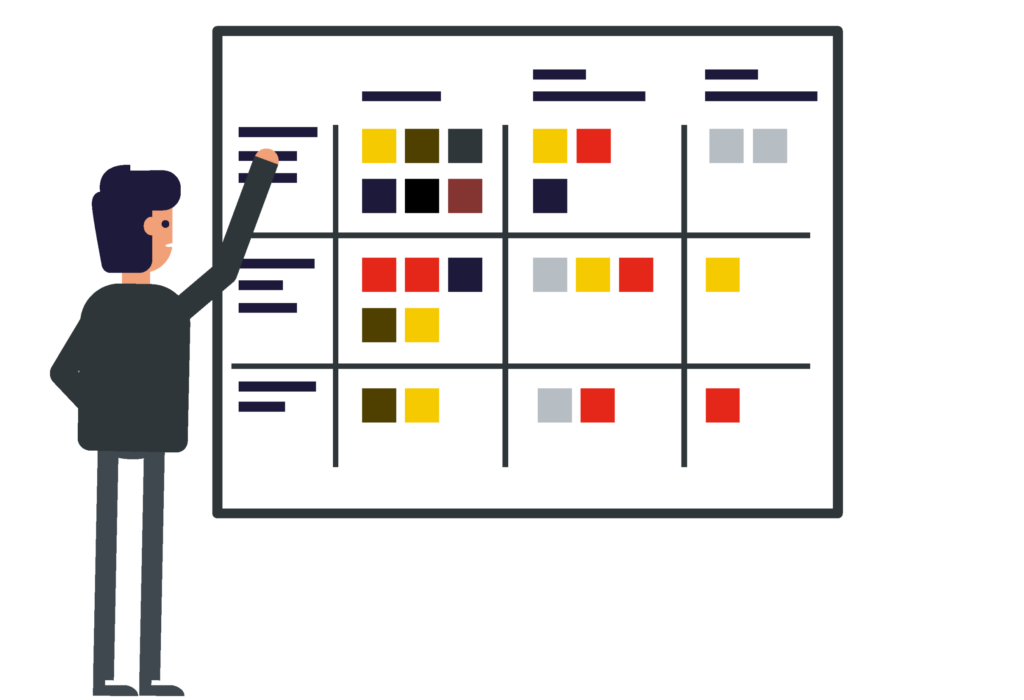Unlock Your Business Potential with HOBA®'s 12 Guiding Principles
Streamline Processes, Enhance Collaboration, and Achieve Continuous Improvement
HOBA®’s 12 guiding principles are a set of powerful tools designed to empower organizations to reach their full potential. These principles are based on years of research and experience, and have been proven to drive agile business transformation and sustained success.
By adopting these principles, businesses can streamline their processes, enhance collaboration, and achieve continuous improvement, leading to increased productivity and profitability.

HOBA® Principles are based off Agile principles
HOBA® and the Design Process are based on based on Agile Scrum iterative continuous development. Similar to Agile, HOBA® has the following principles based on the three (3) themes of – Regular Delivery of Architecture views (i.e. Reference Models, Building Blocks, Blueprints), Team Communication and Design Excellence.

Optimizing Operations for Success
HOBA®’s 12 principles are specifically designed to help organizations optimize their operations and adapt to changing market conditions. By implementing these principles, businesses can make the most of their resources and work more efficiently, ensuring that they stay ahead of the curve and maintain a competitive edge. Whether you are a small business owner or the CEO of a large multinational corporation, HOBA®’s principles can provide the guidance and inspiration you need to achieve your goals and succeed in today’s challenging business environment.
Tested and Trusted
Our principles aren’t just theoretical jargon – they’re combat-proven strategies used by top-tier companies and endorsed by business visionaries. We’ve set the gold standard. HOBA® has been instrumental in the success stories of numerous industry leaders, from the tech giants to the niche disruptors, underpinning their sustained growth and market dominance.

HOBA® Principles
Below is the twice (12) HOBA® Principles. Click each principle to scroll down to the expanded definition:
- 1 - Early and continuous delivery of valuable Architecture views
- 2 - Provides leadership in the benefits realisation strategy and plan
- 3- Delivering Architecture usable views is primary measure of progress
- 4 - Maintain a sustainable pace of development
- 5 - Business people and Architects (Business & IT) must work together daily
- 6 - Face-to-face conversation is most effective to convey information between teams
- 7 - Best Architectures emerge from self-organising teams
- 8 - Build teams around motivated individuals and provide support and trust
- 9 - Reflect regularly, tune and adjust process and behaviour to become more effective
- 10 - Continuous focus on technical excellence
- 11 - Simplicity is the art to minimising wasteful work
- 12 - Welcome changing requirements for customer’s advantage
What are HOBA® Principles?
HOBA® Principles are based off Agile principles for software development, adapted and applied to Business Architecture as follows.
Regular Delivery of Business Architecture Views
#1 - Early and continuous delivery of valuable Architecture views
The HOBA® approach involves the consistent and timely delivery of well-designed and appropriate defined architecture views, each one depicting a different aspect of the overall business architecture and business transformation. These views are presented in a clear and organized manner, with both strategic and operational (implementation) components representing a different view of the business architecture.
#2 - Provides leadership in the benefits realisation strategy and plan
HOBA® provides the leadership in benefits realization strategy and plan that is developed with the Operations (Business-Operations) as the tactical/operational business benefits the 'Business' plans and intends to realise from the organisations transformation. The Business is actively involved in defining the benefits they intend to realise and identifying and agreeing the changes (people, process, technology and data) needed to realise the benefits.
#3 - Delivering Architecture usable views is primary measure of progress
HOBA® promotes regularly shares developing architecture with Business stakeholders, knowing their priorities and requirements will change as they view their Business differently. 'Diminishing value' sets in the longer blueprints are worked on without feedback.
#4 - Maintain a sustainable pace of development
HOBA® encourages a steady realise of business architecture view that is sustainable to the Project and program team, but also the impacted Business stakeholders. Change, by definition causes disruption, Transformation (large changes) can stifle any change effort. HOBA® promotes team's work at a steady and consistent pace, to get momentum, and maintain it through tracking progress and visualised on the kanban board ensuring the transformation stays on track.
Team Communication
#5 - Business people and Architects (Business & IT) must work together daily
HOBA® promotes involving both Business-stakeholders and Technology/IT-people in Architecture development. HOBA® encourages the active involvement of business stakeholders in the development of architecture views, ensuring that their requirements and priorities are captured from the beginning. This helps to ensure that the final architecture aligns with the needs and goals of the business.
#6 - Face-to-face conversation is most effective to convey information between teams
Face-to-face conversation is most effective to convey information between teams. Face-to-face communication is key in HOBA®, as it allows for more effective and efficient exchange of information and ideas between business stakeholders, architects, and other project team members. This also helps to build rapport, trust, understanding, and alignment among all stakeholders.
#7 - Best Architectures emerge from self-organizing teams
HOBA® promotes self-organising teams with members collaborating in an open and flexible manner. They are constantly adapting and evolving their ideas and processes, creating an architecture that is efficient and effective. The best architecture emerges from a team that is constantly collaborating and adapting, with everyone working together towards a common goal. The environment is open and inclusive, with individuals taking ownership and accountability for their tasks.
#8 - Build teams around motivated individuals and provide support and trust
A key aspect of Agile methodologies, including HOBA®, is it emphasizes the value of people and their interactions over processes and tools. This means focusing on empowering individuals, understanding their strengths, and encouraging collaboration rather than relying on rigid processes or tools, encouraging autonomy, continuous learning, open communication, and recognition for contributions. This leads to a more engaged team that takes ownership of their work.
#9 - Reflect regularly, tune and adjust process and behaviour to become more effective
Continuous improvement is a core principle of HOBA®. It involves regularly reflecting on how the team is working together and identifying areas for improvement. This highlights the importance of agile ceremonies including daily standups and retrospectives in promoting continuous improvement, as well as other practices that can enhance team effectiveness, including celebrating successes which is an important aspect of HOBA®. It helps to boost team morale and motivation.
Design Excellence
#10 - Continuous focus on technical excellence
In a team practicing continuous focus on technical excellence, team members constantly review and refine both their architecture views, but also their processes and tools. HOBA® encourages and promotes teams to challenge the status quo, they are always seeking out new and better ways to work together and deliver high quality results (that also means 'not continue to do 'the way its always done around here', but challenging "why is it always done that way around here?" which no one seems to be asking... hence the 70% failure rate in transformations. Following methods that dont work, or did work 50-years ago, but now times are changed, as so has business, and therefore so is the method to transform it).
#11 - Simplicity is the art to minimising wasteful work
HOBA® promotes simplicity in removing waste in avoiding unnecessary work (Heath refers to this as 'marketecture' - interesting but useless). Simplicity is the streamlined flow of work, free from unnecessary steps and clutter. This includes removing complexity in processes and unnecessary tools, clean 'ways of working' with minimal steps, handoffs and distractions. If you want to get 'technical', this is what you call 'lean' or 'being lean'.
#12 - Welcome changing requirements for customer’s advantage
Adapting to changing customer needs and market trends is crucial in the fast-paced business world. HOBA® promotes this through lightweight documentation that can easily be updated as needed, allowing for flexibility when new requirements arise. If you want to get technical, this part here is about 'agile' or 'being agile'. You see, that Agile is first a mindset, then a way of working. This is what we teach and do ourselves. Its not difficult and its not complicated, but for some, its different, different however does not mean wrong. Just a new way of thinking, then working,
We help you transform to the organisation you want.
“The HOBA® framework was pivotal in aligning our transformation initiatives with our strategic business vision.”
HOBA® and Agile
HOBA® is a revolutionary agile framework designed to transform your business and drive organisational efficiency and agility.
Business Agility
Discover how HOBA’s agile business transformation framework empowers organizations to achieve business agility.

